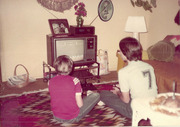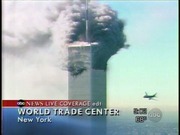tv [untitled] November 5, 2013 1:30pm-2:01pm PST
1:30 pm
francisco and we're doing stay safe and we're going to talk about what shelter in place or safe enough to stay in your home means. we're here at the urban center on mission street in san francisco and joined by carla, the deputy director of spur and one of the persons who pushed this shelter in place and safe enough to stay concept and we want to talk about what it means and why it's important to san francisco. >> as you know the bay area as 63% chance of having a major earthquake and it's serious and
1:31 pm
going to impact a lot of people and particularly people in san francisco because we live on a major fault so what does this mean for us? part of what it means is that potentially 25% of san francisco's building stock will be uninhibit tabl and people can't stay in their homes after an earthquake. they may have to go to shelters or leave entirely and we don't want that to happen. >> we want a building stock to encourage them to stay in the homes and encourage them to stay and not relocate to other locations and shelters. >> that's right so that means the housing needs to be safe enough to stay and we have been focused in trying to define what that means and you as a former building official knows better
1:32 pm
than anybody the code says if an earthquake happens it won't kill you but doesn't necessarily say that can you stay in your home and we set out to define what that might mean and you know because you built this house we're in now and this shows what it's like to be in a place safe enough to stay. it's not going to be perfect. there maybe cracks in the walls and not have gas or electricity within a while but can you essentially camp out within your unit. what's it going to take to get the housing stock up to this standard? we spent time talking about this and one of the building types we talk about was soft story buildings and the ground floor is vulnerable because
1:33 pm
there are openings for garages or windows and during the earthquake we saw in the marina they went right over and those are -- >> very vulnerable buildings. >> very and there are a lot of apartment buildings in san that that are like that. >> and time to. >> >> retrofit the buildings so people can stay in them after the earthquake. >> what do they need? do they need information? do they need incentives? mandates? >> that's a good question. i think it starts with information. people think that new buildings are earthquake proof and don't understand the performance the building will have so we want a transparent of letting people know is my building going to be safe in it after an earthquake? is my
1:34 pm
building so dangers i should be afraid of being injured? so developing a ranking system for buildings would be very important and i think for some of the larger apartment buildings that are soft story we need a mandatory program to fix the buildings, not over night and not without financial help or incentive, but a phased program over time that is reasonable so we can fix those buildings, and for the smaller soft story buildings and especially in san francisco and the houses over garages we need information and incentives and coaxing the people along and each of the owners want their house to be safe enough. >> we want the system and not just mandate everybody. >> that's right. >> i hear about people talking about this concept of resiliency. as you're fixing
1:35 pm
your knowledge you're adding to the city wide resiliency. >> >> what does that mean? >> that's a great question. what spur has done is look at that in terms of recovery and in new orleans with katrina and lost many of the people, hasn't recovered the building stock. it's not a good situation. i think we can agree and in san we want to rebuild well and quickly after a major disaster so we have defined what that means for our life lines. how do we need the gasolines to perform and water perform after an earthquake and the building stock as well, so we have the goal of 95% of our homes to be ready for shelter in place after a major earthquake, and that way people can stay within the city. we don't lose our work force. we don't lose the people that
1:36 pm
make san francisco so special. we keep everybody here and that allow us to recover our economy, and everything because it's so interdependent. >> so that is a difficult goal but i think we can achieve it over the long time so thank you very much for hosting us and hosting this great exhibit, and thank you very much for joining >> welcome to culture wire. we will look at the latest and greatest public art project. recently, the airport unveiled the new state of the art terminal. let's take a look.
1:37 pm
the new terminal service and american airlines and virgin america was designed by a world- renowned architecture's firm. originally built in 1954, the building underwent massive renovation to become the first registered terminal and one of the must modern and sustainable terminals and the united states. the public art program continues its 30-year legacy of integrating art into the airport environment with the addition of five new commissions that are as bold and dynamic as the new building. >> this project was completed in record time, and we were able to integrate the artist's early enough in the process that they could work with the architect said that the work that is completed is the work that really helps complement and instill the space as opposed to
1:38 pm
being tucked away in a corner. >> be experience begins with the glass facades that was designed with over 120 laminated glass panels. it captures the experience of being under or over clouds when flying in a plane. depending on the distance or point of view, it can appear clear for more abstract and atmospheric. the subtle colors change gradually depending on the light and the time of day. >> i wanted to create an art work that looks over time as well as working on in the first glance. the first time you come here, you may not see a. but you may be able to see one side over the other. it features a couple of suspended sculptures. each was created out of a series
1:39 pm
of flat plains run parallel to each other and constructed of steel tubing. >> it is made up of these strata. as the light starts to shift, there is a real sense that there is a dynamism. >> it gives the illusion that this cultures might be fragments of a larger, mysterious mass. >> the environmental artwork livens it with color, light, and the movement. three large woven soldiers are suspended. these are activated by custom air flow program. >> i channeled air flow into each of these forms that makes it move ever so slightly.
1:40 pm
and it is beating like a heart. if-0 when as of the forces of nature moving around us every second. >> shadow patterns reflect the shapes of the hanging sculptures. the new terminal also features a children's play areas. both of the market the exploratory n.y. -- exploratorium. the offer travelers of all ages a playful oasis. using high quality plywood, they created henches shaped like a bird wings that double as musical instruments. serving as a backdrop is a mural featuring images of local birds and san francisco's famous skyline.
1:41 pm
>> in the line between that is so natural, you can see birds and be in complete wilderness. i really like that about this. you could maybe get a little snapshot of what they are expecting. >> it is an interactive, keck sculpture that is interacted with by the visitor. >> they are a lot about and they fall down the belt. it moves the belt up, and if you turn that faster, the butterflies fall in the move of words. >> the art reflect the commission's commitment to acquiring the best work from the bay area and beyond. in addition to the five new
1:42 pm
commissions, 20 artworks that were already in the airport collection were reinstalled. some of which were historically cited in the terminal. it includes major sculptures by the international artists. as a collection, these art works tell the story of the vibrant arts scene in the early 1960's through the mid-1980s's. the illustrate san francisco's cultural center and a place of innovation that is recognized and the love throughout the world. one of the highlights is a series of three left tapestries. they are on view after being in storage for 20 years. these tapestries representing various gardens. from his years of living in san francisco. hydrangeas, chrysanthemums, and whilst dahlias in rich, deep
1:43 pm
shades as they make their way to the baggage area. they can access behind-the- scenes information and interviews with the artist through an audio to work. it features archival audio as well as interviews with living artists. he can be accessed on site by dialing the telephone numbers located near the artwork or by visiting the commission's web site. the public art speaks volumes of san francisco as a world-class city with world-class art and culture. for more information, visit
1:48 pm
1:49 pm
constructional engineer and bill harvey. i want to talk about urban myths. what do you think about earthquakes, can you tell if they are coming in advance? >> he's sleeping during those earthquakes? >> have you noticed him take any special? >> no. he sleeps right through them. there is no truth that i'm aware of with harvey that dogs are aware of an impending earthquake. >> you hear the myth all the time. suppose the dog helps you get up, is it going to help you do something >> i hear they are aware of small vibrations. but yes, i read extensively that dogs cannot realize earthquakes. >> today is a spectacular day in san francisco and sometimes people would say this is
1:50 pm
earthquake weather. is this earthquake weather? >> no. not that i have heard of. no such thing. >> there is no such thing. >> we are talking about the weather in a daily or weekly cycle. there is no relationship. i have heard it's hot or cold weather or rain. i'm not sure which is the myth. >> how about time of day? >> yes. it happens when it's least convenient. when it happens people say we were lucky and when they don't. it's terrible timing. it's never a good time for an earthquake. >> but we are going to have one. >> how about the ground swallowing people into the ground? >> like the earth that
1:51 pm
collapsed? it's not like the tv shows. >> the earth does move and it bumps up and you get a ground fracture but it's not something that opens up and sucks you up into haddes. >> it's not going anywhere. we are going to have a lot of damage, but this myth that california is going to the ocean is not real. >> southern california is moving north. it's coming up from the south to the north. >> you would have to invest the million year cycle, not weeks or years. maybe millions of
1:52 pm
years from now, part of los angeles will be in the bay area. >> for better or worse. >> yes. >> this is a tough question. >> those other ones weren't tough. >> this is a really easy challenge. are the smaller ones less stress? >> yes. the amount released in small earthquakes is that they are so small in you need many of those. >> i think would you probably have to have maybe hundreds of magnitude earthquakes of 4.7. >> so small earthquakes are not making our lives better in the future? >> not anyway that you can count on. >> i have heard that buildings
1:53 pm
in san francisco are on rollers and isolated? >> it's not true. it's a conventional foundation like almost all the circumstances buildings in san francisco. >> the trans-america was built way before. it's a pretty conventional foundation design. >> i have heard about this thing called the triangle of life and up you are supposed to go to the edge of your bed to save yourself. is there anything of value to that ? >> yes, if you are in your room. you should drop, cover and hold onto something. if you are in school, same thing, kitchen same thing. if you happen to be in your bed, and you rollover your bed, it's not a bad place to be. >> the reality is when we have
1:54 pm
a major earthquake the ground shaking so pronounced that you are not going to be able to get up and go anywhere. you are pretty much staying where you are when that earthquake hits. you are not going to be able to stand up and run with gravity. >> you want to get under the door frame but you are not moving to great distances. >> where can i buy a richter scale? >> mr. richter is selling it. we are going to put a plug in for cold hardware. they are not available. it's a rather complex. >> in fact we don't even use the richter scale anymore. we use a moment magnitude. the richter scale was early technology. >> probably a myth that i hear most often is my building is just fine in the loma prieta
1:55 pm
earthquake so everything is fine. is that true ? >> loma prieta was different. the ground acceleration here was quite moderate and the duration was moderate. so anyone that believes they survived a big earthquake and their building has been tested is sadly mistaken. >> we are planning for the bigger earthquake closer to san francisco and a fault totally independent. >> much stronger than the loma prieta earthquake. >> so people who were here in '89 they should say 3 times as strong and twice as long and that will give them more of an
1:56 pm
62 Views
IN COLLECTIONS
SFGTV: San Francisco Government Television Television Archive
Television Archive  Television Archive News Search Service
Television Archive News Search Service 
Uploaded by TV Archive on

 Live Music Archive
Live Music Archive Librivox Free Audio
Librivox Free Audio Metropolitan Museum
Metropolitan Museum Cleveland Museum of Art
Cleveland Museum of Art Internet Arcade
Internet Arcade Console Living Room
Console Living Room Open Library
Open Library American Libraries
American Libraries TV News
TV News Understanding 9/11
Understanding 9/11





























